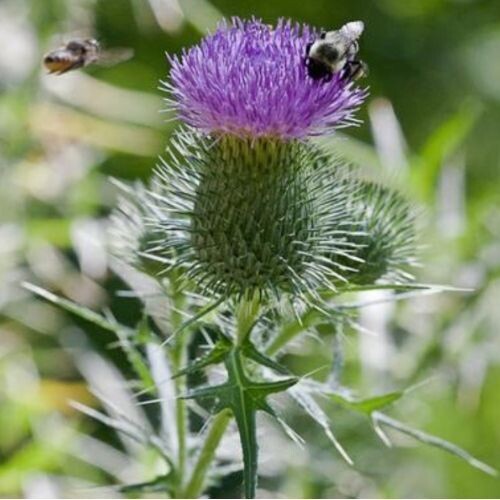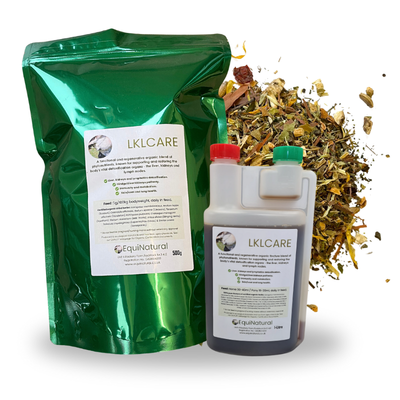MILK THISTLE SEED (Silybum marianum)
Available either as a dried herb or herbal tincture.
Please note this is a nutritional, functional horse food supplement and not veterinary medicine.
See Dr Kellon's Horse Sense - 'Nutrition is not 'Alternative' Therapy.
Tincture
Our human-grade, certified organic tinctures give you a ready-to-absorb potent source of phytonutrients at the highest-strength available, for immediate absorption straight into the bloodstream and to the body’s cells.
- 100% certified organic pure tincture
Carduus marianus (Milk Thistle) Seed, Decocted 1:3 65% , Organically Cultivated
- Feed Guide
- 6ml/100kg bodyweight, daily in feed.
- Always shake the bottle to disperse any sediment.
- 3-year shelf-life.
Dried Herb
Produced to ecological standards and free from agro-chemicals.
- Certified organic dried herb
Silybum marianum (Milk Thistle) Seed , Organic Cultivated, Origin Turkey
- Feed Guide
- 5g/100kg bodyweight per day, thus for an average 500kg horse add 25g daily to feed.
- 1-year shelf-life.
Functional Nutritional Value
Constituents: Flavolignans (including isosilybinin, silybinin, silychristin, and silydianin, which together are referred to as silymarin), fixed oil, sterols (cholesterol, campesterol, stigmasterol, sitosterol), gamma linoleic acid, amines (tyramine, histamine, betaine), bitter principles, flavonoids (apigenin, quercetin, kaempferol), lignans, mucilage.
NB. Our range of botanicals are all grown, harvested and dried without the use of agri-chemicals, non-irradiated and GMO free - see our Quality page for Quality Management & Certification Documents. Laboratory tested for identification and compliance to the British and European Pharmacopoeia standards, and are human grade. Please be aware that if you're purchasing our dried botanicals for human use, our dried range is cut to appropriate sizes for feeding to horses.
More ...
Medicinally speaking, when it comes to milk-thistle's medicinal prowess, it's all about the seed. The most researched and utilised part of milk thistle is the seed, with the leaves, flowers and roots used more as human food. It’s still eaten in myriad ways across the world, with the seeds roasted similarly to chicory and coffee, and careful preparations of the nutritious de-thorned stalks can be roasted or added to a stir-fry. The first century naturalist and physician Pliny the Elder (A.D. 23-79) also wrote about the nutritious properties of milk thistle but mentioned that it was too difficult an ingredient to cook with!
These days the seeds are eaten during times of famine or as animal feed, and on the Indian continent they’re sold as a street snack like sunflower seeds. A particularly popular condiment that’s added to a variety of middle-eastern dishes consists of dry-roasted milk thistle and sesame seeds, with ground seaweed, black pepper and sea salt.
Medicinally speaking, milk thistle has been used since at least the first century A.D. with written accounts saying that the thistle was most likely used in the sparing of early humans who inadvertently consumed toxic substances. From ancient Greece to medieval Europe and on to the 20th century, documents show milk thistle’s various capacities, from assisting in lactation to lifting melancholy moods, preventing plague and infection, as well as cleaning the blood.
The first recorded use of milk thistle for liver-related conditions comes from Pliny the Elder, who wrote of mixing the juice of the plant with honey for “carrying off bile.” In 1789, the herbalist Nicolas Culpepper wrote that both internal and topical use of “the seed and distilled water” were useful in the cases of jaundice and “obstructions of the liver and spleen”. The 18th century German physician Stahl noted that the seeds were extremely useful in respiratory conditions associated with hepatic fever.
Cut to the 20 th century and on hearing about the use of milk thistle for chronic liver disease, acute hepatitis and jaundice, the German scientist H. Schultz began to research the clinical value of milk thistle. As a result, in 1958 the first attempts to isolate milk thistle constituents finally began, and 10-years later researchers in Munich successfully isolated the flabonolignan complex and named it silymarin.
In Traditional Chinese Medicine (TCM), milk thistle seed is considered a cooling and nourishing therapeutic support to liver-spleen Blood and Yin, reducing heat in the liver (inflammation), strengthening function and structure by offering tone where there is weakness, and resolving toxins. Milk thistle is taken as a tonic over time, and a strong resilient liver is considered more able to effectively deal with the stress and toxicity of the modern world.
In Ayurvedic herbal practice, milk thistle is likewise thought of as relating to the liver and digestion in its cleansing, detoxifying, and nourishing properties.
Milk thistle seed as a therapeutic agent has been used in Western herbalism for thousands of years as a nourishing, restorative, and cooling tonic for the liver and digestive tract, and is nearly always indicated in situations where the liver appears to be stressed. Opinions also saying it behaves similarly to yarrow in its ability to both move congested blood/haemorrhaging, as well as a useful spleen and lymphatic herb .
The decongestive properties of milk thistle extend to other systems of 'movement' in the body, including the spleen, kidneys, and veins, but either way the mechanisms by which milk thistle relieves congestion and nourishes the body’s systems are many, principally acting in protective, restorative, and stimulating ways to the liver, digestion, and other eliminative and circulatory systems.
Milk thistle is thought to protect the liver from damage created by ingested toxins, alcohol, recreational and pharmaceutical drugs, and environmental toxins such as heavy metal, with both preventative and curative potential actions. The rapid liver cell regeneration, for which milk thistle is so well known, appears to be due to silymarin ; it’s been shown to alert the cell membrane so that certain toxins are unable to enter the cells.
Equally, its anti-inflammatory and antioxidant actions are thought to combine with its immune-enhancing capacities, stimulating production and function of neutrophils, T lymphocytes, and leucocytes, in turn inhibiting the growth of certain cancer cells. Other immune-related research in the past year has shown significant antibacterial and antifungal activity.
Other research has shown it to be protective to the cells of the kidneys, offering similar support in cases of intoxication by environmental chemicals and pharmaceutical interventions. While not particularly recognised for its effects on the nervous system, recent research has shown milk thistle to improve neurological and age-related conditions such as Alzheimer’s and Parkinson’s disease.
These days it’s suggested that milk thistle is a primary therapeutic ally of 21st century living due to its ability to assist the human body in the liver function and detoxification needed to deal with modern industrial fast-paced lifestyles. Many argue that silymarin and milk thistle preparations have been shown to be the best documented treatment for liver intoxication. It’s even been said that there’s no pharmaceutical equivalent for the powers of this humble seed!
Milk thistle features in many of our blends where liver, kidney and immunoprotective is required. You'll find it in all our Immunity CARE blends, as well as our two CushTonics , EyeTonic , MellowMare , MetaTonic , and our WildFed.
Safety
- Most clinicians consider milk thistle to be a very safe herb that can complement most health practices and formulas, as the reports of toxicity and side effects are few and limited to mild laxative effects in some individuals (Foster, 2009).
- Because research suggests the milk thistle may induce the cytochrome p450 pathway in the liver, its possible that the use of milk thistle may interfere with the levels of certain pharmaceuticals (cardiac glycosides, cyclosporine, birth control, metronidazole (Flagyl)) that are metabolized via this process (Duke, 2010; McIntyre, n.d.).






